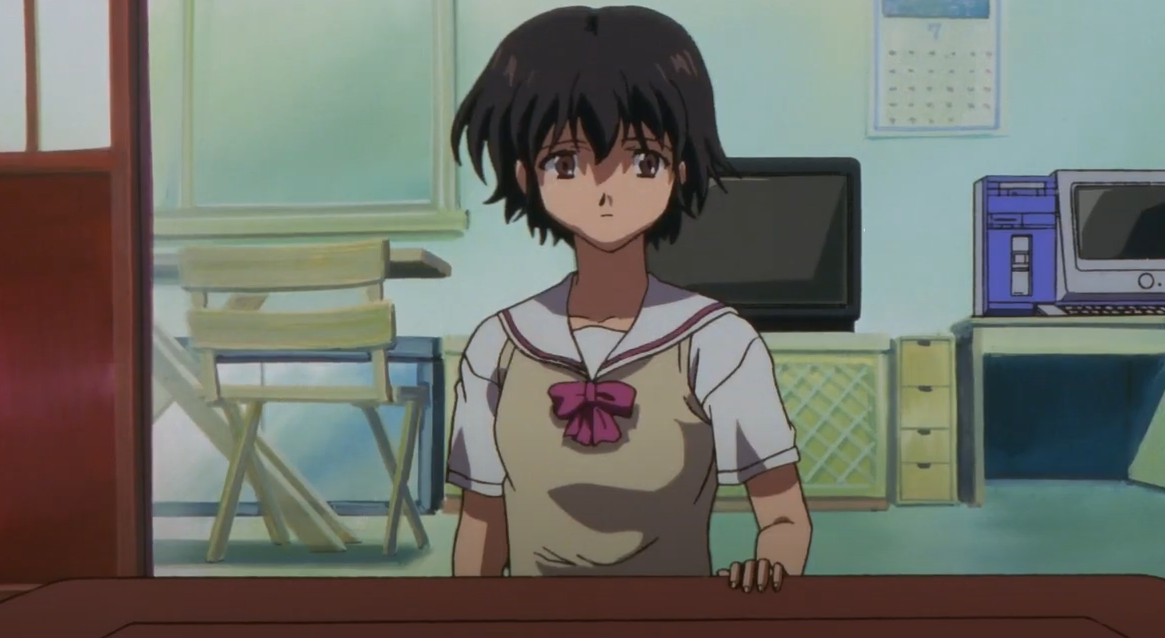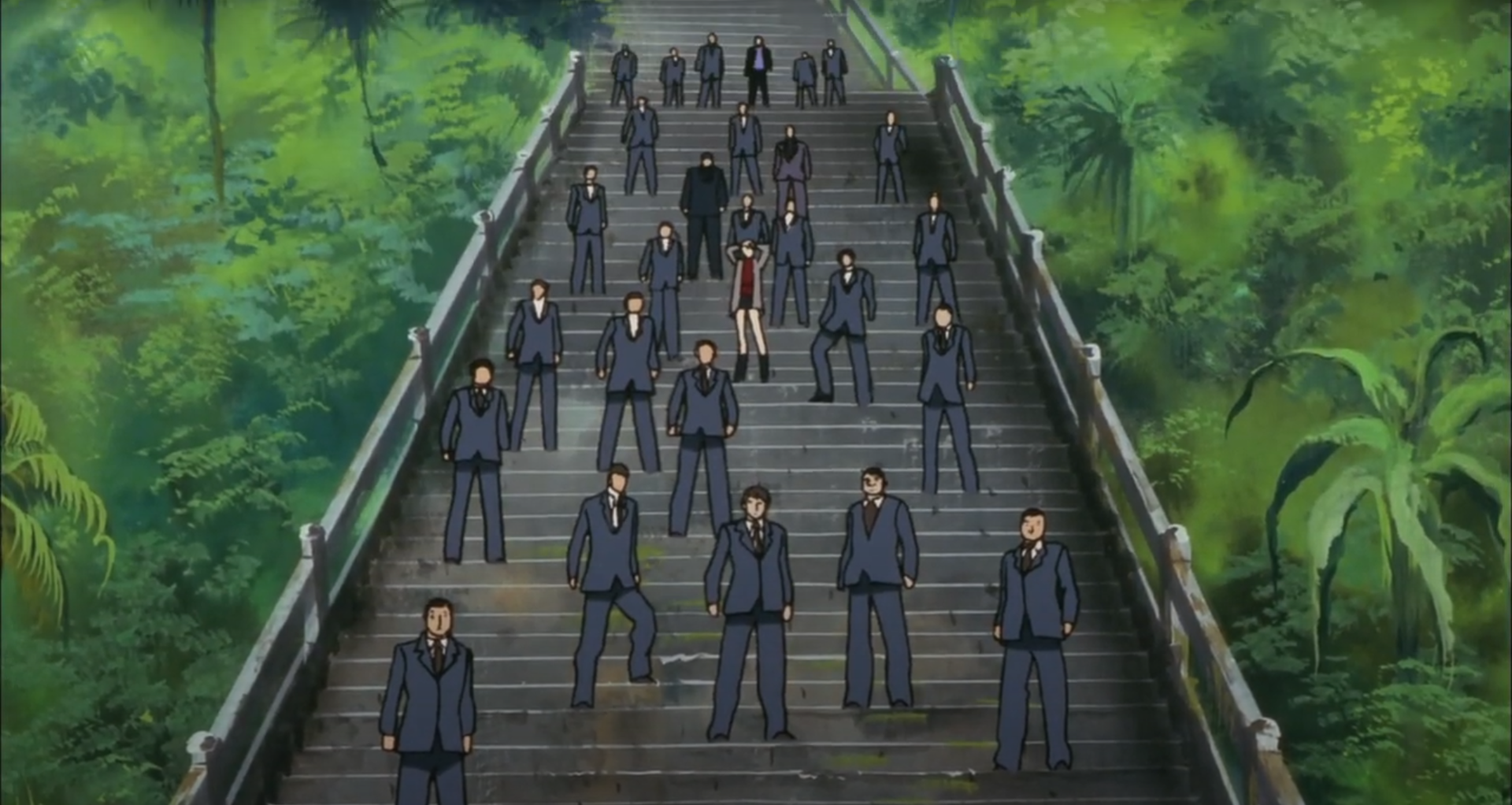魔保育小說16年完,個故完整,只係近排出續集
打萬魔殿吸引喎,作畫又正
近排瘋狂補番(2)
命名與必然性
996 回覆
71 Like
4 Dislike
決定補點兔
開始唔夠一分鐘有呢幕係咪想致敬ARIA

開始唔夠一分鐘有呢幕係咪想致敬ARIA


搵下有冇source先
頭先wiki 魔保育望到 出版期間 2012年6月8日-出版中
就當未完
頭先wiki 魔保育望到 出版期間 2012年6月8日-出版中
就當未完

limited易搵中文,劇情夠激烈,有全書最強魔法少女
反正啲角色基本全新人,而且劇情比較接無印
反正啲角色基本全新人,而且劇情比較接無印
都係覺得太刻意賣萌賣角
例如呢幕就冇劇情需要

停一停補其他先
例如呢幕就冇劇情需要

停一停補其他先

人設咁EVA feel(貞本義行?)嘅 

Wiki: キャラクターデザイン 菊地洋子 芝美奈子 宮地聡子


Wiki: キャラクターデザイン 菊地洋子 芝美奈子 宮地聡子
Sorry年代太遠記錯左
咁真係要搵返當年既訪問/紀錄先知phantom TV個結局係入黑田定虛淵數

咁真係要搵返當年既訪問/紀錄先知phantom TV個結局係入黑田定虛淵數
NOIR 到而家比較常提起既都係梶浦由記做既BGM,開live經常會表演/唱
早期成名作
之後既MADLAX、EL CAZADOR都係同樣班底
早期成名作
之後既MADLAX、EL CAZADOR都係同樣班底
睇完第一集幾啱口味 
槍、少女、殺手(黑社會?)、命運(砣錶?)
第1集配樂真係幾突出
Wiki 睇 staff list 見到音樂係梶浦由記
唔知配樂係咪佢負責
定音樂指果2首插入歌

槍、少女、殺手(黑社會?)、命運(砣錶?)
第1集配樂真係幾突出
Wiki 睇 staff list 見到音樂係梶浦由記
唔知配樂係咪佢負責
定音樂指果2首插入歌

配樂係佢呀
staff list寫音樂就係指配樂
OP/ED/插曲 會另外寫的
staff list寫音樂就係指配樂
OP/ED/插曲 會另外寫的
借位問日文勁人 


就我理解君(くん)通常稱呼男性朋友/同輩/後輩用
如果個妹係男仔頭,又有其他朋友在場,家姐有無可能叫自己個妹做xxxくん?



就我理解君(くん)通常稱呼男性朋友/同輩/後輩用
如果個妹係男仔頭,又有其他朋友在場,家姐有無可能叫自己個妹做xxxくん?

睇咗幾集NOIR
覺得要惡補下D基本電影知識
某入門Textbook (download file 風險自行承擔)
https://pdfcoffee.com/jill-nelmes-introduction-to-film-studies-routledge-2012pdf-2-pdf-free.html
未正式睇,貌似雞精 review
http://file.upi.edu/Direktori/FPBS/JUR._PEND._BAHASA_INGGRIS/197104242006042-NIA_NAFISAH/Makalah_dll/Film_Studies.pdf
EDB 教材
https://www.edb.gov.hk/attachment/en/curriculum-development/kla/eng-edu/references-resources/Resource%20Materials%20on%20Learning%20and%20Teaching%20of%20Film.pdf
Keywords / Terminology
https://cpb-ap-se2.wpmucdn.com/thinkspace.csu.edu.au/dist/5/1410/files/2015/10/Cinema-Studies-Key-Concepts-1-289afca.pdf
覺得要惡補下D基本電影知識

某入門Textbook (download file 風險自行承擔)
https://pdfcoffee.com/jill-nelmes-introduction-to-film-studies-routledge-2012pdf-2-pdf-free.html
未正式睇,貌似雞精 review
http://file.upi.edu/Direktori/FPBS/JUR._PEND._BAHASA_INGGRIS/197104242006042-NIA_NAFISAH/Makalah_dll/Film_Studies.pdf
EDB 教材

https://www.edb.gov.hk/attachment/en/curriculum-development/kla/eng-edu/references-resources/Resource%20Materials%20on%20Learning%20and%20Teaching%20of%20Film.pdf
Keywords / Terminology
https://cpb-ap-se2.wpmucdn.com/thinkspace.csu.edu.au/dist/5/1410/files/2015/10/Cinema-Studies-Key-Concepts-1-289afca.pdf
NOIR場景耐唔耐就重複
係表現手法定條片源有問題
1:52~
8:59~
https://www.youtube.com/watch?v=DzeDYTrYA80&list=PLi3H7LS-LpLgubbxMarOfP-BY0SzPMDTS&index=7
係表現手法定條片源有問題

1:52~
8:59~
https://www.youtube.com/watch?v=DzeDYTrYA80&list=PLi3H7LS-LpLgubbxMarOfP-BY0SzPMDTS&index=7
睇到咁正式

近排黎咗幾個新人
水平差太遠
參與唔到你地D討論
係時候認真學習下
以前一直抗拒深入研究同睇分析係覺得動畫只係娛樂,唔係興趣,認真研究就本末倒置
分析力上升就會擔心分散注意力,每分每秒係度搵線索諗暗喻,反而享受唔到作品本身
水平差太遠
參與唔到你地D討論
係時候認真學習下

以前一直抗拒深入研究同睇分析係覺得動畫只係娛樂,唔係興趣,認真研究就本末倒置
分析力上升就會擔心分散注意力,每分每秒係度搵線索諗暗喻,反而享受唔到作品本身

舉個例
睇女子高中無所事事個OP (https://www.agemys.net/play/20190158?playid=2_1 1分56秒)
會即時諗起FLCL ED 同 toe個MV
呢種技巧應該有專有名詞,但唔識就係唔識
(要我夾硬形容就叫cut frame拍攝)
up唔出名堂就好難google
google唔到+閱歷少就唔知呢種手法幾時開始興起 / 邊條片首創 / 最出名係邊幾條片等
FLCL ED
https://www.youtube.com/watch?v=tdjNcgdnRyk&t=42s
toe Goodbye MV
https://www.youtube.com/watch?v=e1pZIfretEs
睇女子高中無所事事個OP (https://www.agemys.net/play/20190158?playid=2_1 1分56秒)
會即時諗起FLCL ED 同 toe個MV
呢種技巧應該有專有名詞,但唔識就係唔識
(要我夾硬形容就叫cut frame拍攝)
up唔出名堂就好難google
google唔到+閱歷少就唔知呢種手法幾時開始興起 / 邊條片首創 / 最出名係邊幾條片等

FLCL ED
https://www.youtube.com/watch?v=tdjNcgdnRyk&t=42s
toe Goodbye MV
https://www.youtube.com/watch?v=e1pZIfretEs
denotation/connotation
... Denotation means the literal relationship between sign and referent; thus, three denotes the object referred to. In film terms, this first order of meaning would refer to what is on the screen, that is, the mechanical (re)production of an image: for example, three people in a frame (a three-shot), two men and a woman. The second order of meaning, connotation, adds values that are culturally encoded to that first order of meaning. And it is at this second order of signification that we can see how signs operate as myth-makers. That is, they function as crystallizers of abstract concepts or concepts that are difficult to conceptualize – they make sense of the culture (for example, institutional, social) in which individuals or communities find themselves.
Returning, by way of illustration, to this three-shot. At the denotative level, the two men are standing either side of the woman. The main source of lighting is coming from the side, casting one of the men into the shadows. The camera is at a slight low angle, thereby slightly distorting the features of the characters. At the connotative level of meaning, the reading produced is as follows: this image is signifying the dangers of a triangular relationship. In classic narrative cinema – which reposes on the triad order/ disorder/order-restored – convention has it that a triangular relationship must end with the demise of one character (the man in the shadows), so that order can be re-established. Within that denotation/connotation cultural convention we can also see how the third order of signification, myth, gets produced and feeds into ideology. The myth that triangular relationships are doomed, and cause disruption
to order, implicitly makes clear that heterosexual coupledom is the only ideologically acceptable face of sexuality.
諗諗吓我成日睇唔明劇情嘅最大問題係太少同人交流 / 睇得太少分析
connotation 係約定俗成,convention 難聽D講都係 arbitrary (唔同文化再有差異),prototypical 嘅共通解讀都幾重要 (平行世界可以理解光 = 邪惡,影 = 正義)
冇convention我話男女男代表好嬲 (鬼佬導演「可以」借用粵語) 都得架啦
up up下又變咗作者背景同文本關係
... Denotation means the literal relationship between sign and referent; thus, three denotes the object referred to. In film terms, this first order of meaning would refer to what is on the screen, that is, the mechanical (re)production of an image: for example, three people in a frame (a three-shot), two men and a woman. The second order of meaning, connotation, adds values that are culturally encoded to that first order of meaning. And it is at this second order of signification that we can see how signs operate as myth-makers. That is, they function as crystallizers of abstract concepts or concepts that are difficult to conceptualize – they make sense of the culture (for example, institutional, social) in which individuals or communities find themselves.
Returning, by way of illustration, to this three-shot. At the denotative level, the two men are standing either side of the woman. The main source of lighting is coming from the side, casting one of the men into the shadows. The camera is at a slight low angle, thereby slightly distorting the features of the characters. At the connotative level of meaning, the reading produced is as follows: this image is signifying the dangers of a triangular relationship. In classic narrative cinema – which reposes on the triad order/ disorder/order-restored – convention has it that a triangular relationship must end with the demise of one character (the man in the shadows), so that order can be re-established. Within that denotation/connotation cultural convention we can also see how the third order of signification, myth, gets produced and feeds into ideology. The myth that triangular relationships are doomed, and cause disruption
to order, implicitly makes clear that heterosexual coupledom is the only ideologically acceptable face of sexuality.
諗諗吓我成日睇唔明劇情嘅最大問題係太少同人交流 / 睇得太少分析
connotation 係約定俗成,convention 難聽D講都係 arbitrary (唔同文化再有差異),prototypical 嘅共通解讀都幾重要 (平行世界可以理解光 = 邪惡,影 = 正義)
冇convention我話男女男代表好嬲 (鬼佬導演「可以」借用粵語) 都得架啦
up up下又變咗作者背景同文本關係

不僅僅只是動畫,電影其實是地域性很強的東西。 一旦我們理解了美國電影,就說明我們的思想有所偏離。 日本人做不到像美國人那樣欣賞美國電影;同樣的,美國人也很難理解《機動警察》電影要講什麼。 所謂的「電影是世界性的」不過是空想,電影的世界裡也是存在著國界的啊。 我們享受著美國電影的時候,實際上正遭受著一種文化侵略。
好似係押井守嘅一d訪談, 我覺得幾有趣
好似係押井守嘅一d訪談, 我覺得幾有趣
https://www.youtube.com/watch?v=7lUFluLOh-s&t=483s
應該係step printing
應該係step printing
劇情 (plot) 應該係相對易理解既部分
context通常先有較大分歧 鏡頭/narrative/音聲etc 都對成品有影響
context通常先有較大分歧 鏡頭/narrative/音聲etc 都對成品有影響
用step printing個方向諗,似乎<1 fps 就做到個效果 (真人條片分分鐘相機都做到) 
學到野,似乎王家衛玩step printing好出名

學到野,似乎王家衛玩step printing好出名

「電影是世界性的」個講法有歧義
佢個諗法係唔似足球、數學、電子遊戲之類,文化會影響電影(或各媒體藝術)解讀
但美國人都未必100%「識欣賞」美國片
日本人都唔會100%「睇得明」機動警察
我諗睇開商業片、唔深究電影嘅香港人,同任何國家嘅電影愛好者比較,肯定後者更識欣賞王家衛,呢點應該符合「電影是世界性的」

佢個諗法係唔似足球、數學、電子遊戲之類,文化會影響電影(或各媒體藝術)解讀
但美國人都未必100%「識欣賞」美國片
日本人都唔會100%「睇得明」機動警察
我諗睇開商業片、唔深究電影嘅香港人,同任何國家嘅電影愛好者比較,肯定後者更識欣賞王家衛,呢點應該符合「電影是世界性的」

narrative, ambiguity, preferred reading, codes and conventions
呢幾個keywords有排睇
呢幾個keywords有排睇

NOIR
一條女射瓜1x條友快過1x條友其中1條射瓜條女
係咪turn-based game


一條女射瓜1x條友快過1x條友其中1條射瓜條女
係咪turn-based game



